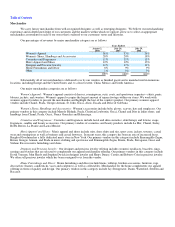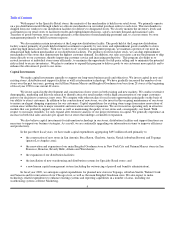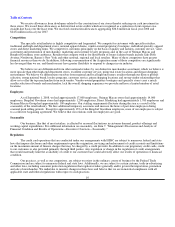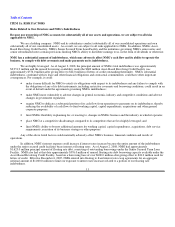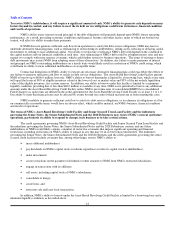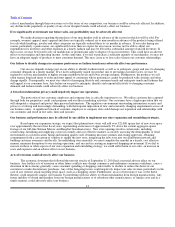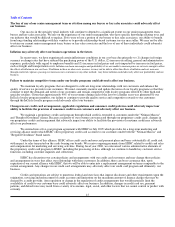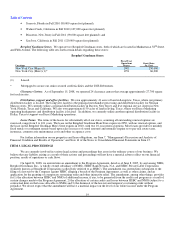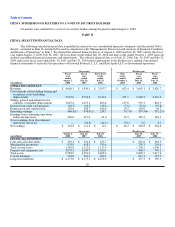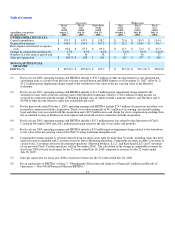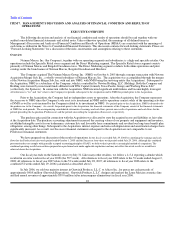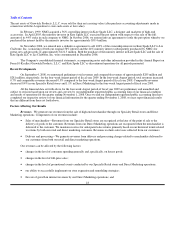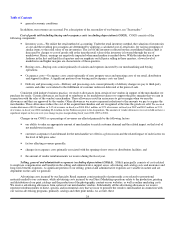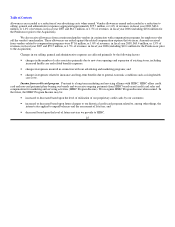Neiman Marcus 2007 Annual Report Download - page 19
Download and view the complete annual report
Please find page 19 of the 2007 Neiman Marcus annual report below. You can navigate through the pages in the report by either clicking on the pages listed below, or by using the keyword search tool below to find specific information within the annual report.
Table of Contents
Our business can be affected by extreme or unseasonable weather conditions.
Extreme weather conditions in the areas in which our stores are located could adversely affect our business. For example,
heavy snowfall, rainfall or other extreme weather conditions over a prolonged period might make it difficult for our customers to
travel to our stores and thereby reduce our sales and profitability. Our business is also susceptible to unseasonable weather conditions.
For example, extended periods of unseasonably warm temperatures during the winter season or cool weather during the summer
season could render a portion of our inventory incompatible with those unseasonable conditions. Reduced sales from extreme or
prolonged unseasonable weather conditions would adversely affect our business.
We are subject to numerous regulations that could affect our operations.
We are subject to customs, truth-in-advertising and other laws, including consumer protection regulations and zoning and
occupancy ordinances that regulate retailers generally and/or govern the importation, promotion and sale of merchandise and the
operation of retail stores and warehouse facilities. Although we undertake to monitor changes in these laws, if these laws change
without our knowledge, or are violated by importers, designers, manufacturers or distributors, we could experience delays in
shipments and receipt of goods or be subject to fines or other penalties under the controlling regulations, any of which could adversely
affect our business.
Our revenues and cash requirements are affected by the seasonal nature of our business.
The specialty retail industry is seasonal in nature, with a higher level of sales typically generated in the fall and holiday
selling seasons. We have in the past experienced significant fluctuation in our revenues from quarter to quarter with a disproportionate
amount of our revenues falling in our second fiscal quarter, which coincides with the holiday season. In addition, we have significant
additional cash requirements in the period leading up to the months of November and December in anticipation of higher sales volume
in those periods, including payments relating to additional inventory, advertising and employees.
Our business is affected by foreign currency fluctuations.
We purchase a substantial portion of our inventory from foreign suppliers whose cost to us is affected by the fluctuation of
their local currency against the dollar or who price their merchandise in currencies other than the dollar. Fluctuations in the Euro-U.S.
dollar exchange rate affect us most significantly; however, we source goods from numerous countries and thus are affected by changes
in numerous currencies and, generally, by fluctuations in the U.S. dollar relative to such currencies. Accordingly, changes in the value
of the dollar relative to foreign currencies may increase our cost of goods sold and if we are unable to pass such cost increases on to
our customers, our gross margins, and ultimately our earnings, will decrease. Foreign currency fluctuations could have a material
adverse effect on our business, financial condition and results of operations in the future.
Conditions in, and the United States' relationship with, the countries where we source our merchandise could affect our sales.
A substantial majority of our merchandise is manufactured overseas, mostly in Europe. As a result, political instability or
other events resulting in the disruption of trade from other countries or the imposition of additional regulations relating to or duties
upon imports could cause significant delays or interruptions in the supply of our merchandise or increase our costs, either of which
could have a material adverse effect on our business. If we are forced to source merchandise from other countries, those goods may be
more expensive or of a different or inferior quality from the ones we now sell. The importance to us of our existing designer
relationships could present additional difficulties, as it may not be possible to source merchandise from a given designer from
alternative jurisdictions. If we were unable to adequately replace the merchandise we currently source with merchandise produced
elsewhere, our business could be adversely affected.
Significant increases in costs associated with the production of catalogs and other promotional materials may adversely affect
our operating income.
We advertise and promote in-store events, new merchandise and fashion trends through print catalogs and other promotional
materials mailed on a targeted basis to our customers. Significant increases in paper, printing and postage costs could affect the cost of
producing these materials and as a result, may adversely affect our operating income.
16



